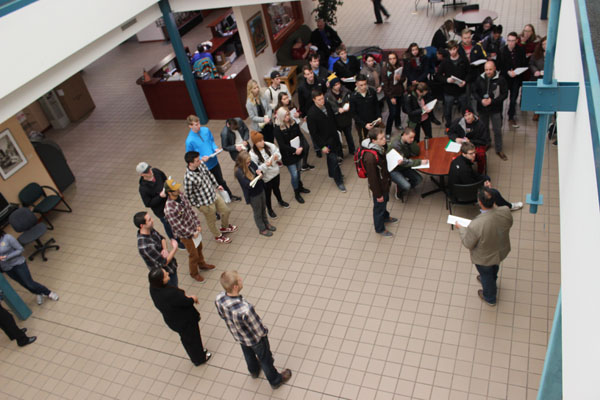UW-Eau Claire students view a cross-section of the Nation’s functions, culture
By Ken Luchterhand

A group of 42 University of Wisconsin - Eau Claire students were given the opportunity to experience how the Ho-Chunk Nation government works, along with a glimpse into the idiosyncrasies of the people’s culture.
Arrangements of the visit were made between Public Relations Specialist Michelle Ramberg and Geography Professor Ezra Zietler, but the connection began a while before.
Both Adam Meinerz and Niklas Anderson are graduates of UW-Eau Claire with majors in Geography, and both were students of Zietler. Meinerz graduated in 2010 and Anderson graduated last fall. Sometime since Anderson’s graduation, he and Zietler had a conversation about coming to visit the Ho-Chunk Nation headquarters.
Zeitler deemed it important to see how two UW-EC geography graduates have transitioned their education into applicable skills in the workforce, along with learning how the Ho-Chunk cultures exists and thrives in a modern world.
Later emailing Ramberg, the visit was arranged for discussion of four subjects: 1. Veterans, 2. Burial and Effigy Mounds, Global Information Systems (GIS), and Gaming Impact on Tribes.
The tour was kicked off in the Tribal Office Building atrium with Jon Greendeer, who gave an overview of the Ho-Chunk culture and history, along with the Ho-Chunk member’s perceptions, understanding and future as a people.
After the overview by Greendeer, the group moved to the Legislative Conference Room where Meinerz and Anderson offered an overview of their work within the Nation and use of GIS.
“The group was mostly geography and environmental majors with some of the cultural spectrum included,” Anderson said. “Some of them had a GIS educational background.”
Greendeer spoke about Ho-Chunk veterans and how Native American dedication and service to the country far surpasses any other ethnic group in the United States.
He also provided some background on the mounds issue and how certain legislators in the Wisconsin government attempted to pass a bill that would allow excavation and desecration of sacred burial and effigy mounds.
As far as Native American gaming in Wisconsin, it has provided an income for Ho-Chunk people, but it doesn’t relieve all the problems, Greendeer said.
“You can’t solve social problems just by throwing money at it,” Greendeer said. Historical generational trauma of the Ho-Chunk people still has an impact on the people and some of those issues are difficult to overcome.
Greendeer told the story of how he gave a presentation in a classroom where a little girl approached him and said, “I’m sorry for what my ancestors did to you.” That caused the teacher to break out in tears.
“I don’t want people to feel bad for what happened in the past,” Greendeer said, “it’s how we go forward – how we go from here – is what we should be concentrating on.”
The tour by the students gave them an opportunity to connect what they are learning in the classroom with what they will experience in the outside world, Anderson said.
“I was excited to give back to my alma mater and share some real life work experience with these students,” Meinerz said. “It was great to have the opportunity share how the Ho-Chunk Nation utilizes GIS.”
Home